Multiple Choice
You are given five test tubes, each containing an unknown protist, and your task is to read the following description and match these five protists to the correct test tube.
In test tube 1, you observe an organism feeding. Your sketch of the organism looks very similar to Figure 28.1. When light, especially red and blue light, is shone on the tubes, oxygen bubbles accumulate on the inside of test tubes 2 and 3. Chemical analysis of test tube 3 indicates the presence of substantial amounts of silica. Chemical analysis of test tube 2 indicates the presence of a chemical that is toxic to fish and humans. Microscopic analysis of organisms in test tubes 2, 4, and 5 reveals the presence of permanent, membrane-bounded sacs just under the plasma membrane. Microscopic analysis of organisms in test tube 4 reveals the presence of an apicoplast in each. Microscopic analysis of the contents in test tube 5 reveals the presence of one large nucleus and several small nuclei in each organism.

Figure 28.1
-Test tube 4 contains
A) Paramecium.
B) Navicula (diatom) .
C) Pfiesteria (dinoflagellate) .
D) Entamoeba.
E) Plasmodium.
Correct Answer:

Verified
Correct Answer:
Verified
Q6: What must occur for asexual reproduction to
Q7: Which of the following are actual mutualistic
Q8: Green algae differ from land plants in
Q9: A crucial photosynthetic gene of the cyanobacterium
Q10: You are designing an artificial drug-delivery "cell"
Q12: Which of the following represents the true
Q13: The next few questions refer to the
Q14: Which of the following is a characteristic
Q15: Which process could have allowed the nucleomorphs
Q16: Biologists suspect that endosymbiosis gave rise to